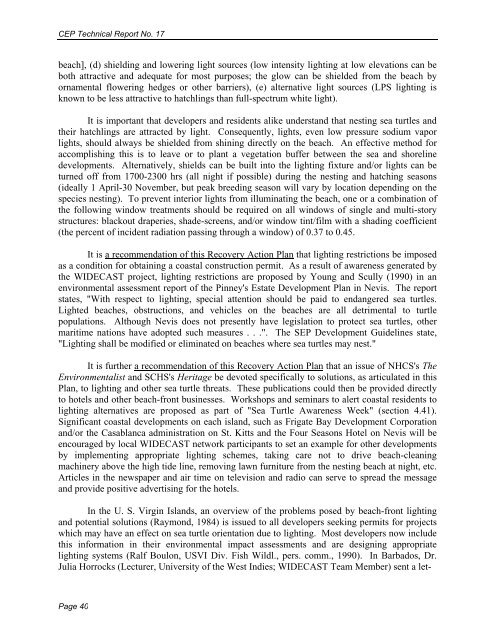Sea Turtle Recovery Action Plan for St. Kitts and Nevis - WIDECAST
Sea Turtle Recovery Action Plan for St. Kitts and Nevis - WIDECAST
Sea Turtle Recovery Action Plan for St. Kitts and Nevis - WIDECAST
You also want an ePaper? Increase the reach of your titles
YUMPU automatically turns print PDFs into web optimized ePapers that Google loves.
CEP Technical Report No. 17<br />
beach], (d) shielding <strong>and</strong> lowering light sources (low intensity lighting at low elevations can be<br />
both attractive <strong>and</strong> adequate <strong>for</strong> most purposes; the glow can be shielded from the beach by<br />
ornamental flowering hedges or other barriers), (e) alternative light sources (LPS lighting is<br />
known to be less attractive to hatchlings than full-spectrum white light).<br />
It is important that developers <strong>and</strong> residents alike underst<strong>and</strong> that nesting sea turtles <strong>and</strong><br />
their hatchlings are attracted by light. Consequently, lights, even low pressure sodium vapor<br />
lights, should always be shielded from shining directly on the beach. An effective method <strong>for</strong><br />
accomplishing this is to leave or to plant a vegetation buffer between the sea <strong>and</strong> shoreline<br />
developments. Alternatively, shields can be built into the lighting fixture <strong>and</strong>/or lights can be<br />
turned off from 1700-2300 hrs (all night if possible) during the nesting <strong>and</strong> hatching seasons<br />
(ideally 1 April-30 November, but peak breeding season will vary by location depending on the<br />
species nesting). To prevent interior lights from illuminating the beach, one or a combination of<br />
the following window treatments should be required on all windows of single <strong>and</strong> multi-story<br />
structures: blackout draperies, shade-screens, <strong>and</strong>/or window tint/film with a shading coefficient<br />
(the percent of incident radiation passing through a window) of 0.37 to 0.45.<br />
It is a recommendation of this <strong>Recovery</strong> <strong>Action</strong> <strong>Plan</strong> that lighting restrictions be imposed<br />
as a condition <strong>for</strong> obtaining a coastal construction permit. As a result of awareness generated by<br />
the <strong>WIDECAST</strong> project, lighting restrictions are proposed by Young <strong>and</strong> Scully (1990) in an<br />
environmental assessment report of the Pinney's Estate Development <strong>Plan</strong> in <strong>Nevis</strong>. The report<br />
states, "With respect to lighting, special attention should be paid to endangered sea turtles.<br />
Lighted beaches, obstructions, <strong>and</strong> vehicles on the beaches are all detrimental to turtle<br />
populations. Although <strong>Nevis</strong> does not presently have legislation to protect sea turtles, other<br />
maritime nations have adopted such measures . . .". The SEP Development Guidelines state,<br />
"Lighting shall be modified or eliminated on beaches where sea turtles may nest."<br />
It is further a recommendation of this <strong>Recovery</strong> <strong>Action</strong> <strong>Plan</strong> that an issue of NHCS's The<br />
Environmentalist <strong>and</strong> SCHS's Heritage be devoted specifically to solutions, as articulated in this<br />
<strong>Plan</strong>, to lighting <strong>and</strong> other sea turtle threats. These publications could then be provided directly<br />
to hotels <strong>and</strong> other beach-front businesses. Workshops <strong>and</strong> seminars to alert coastal residents to<br />
lighting alternatives are proposed as part of "<strong>Sea</strong> <strong>Turtle</strong> Awareness Week" (section 4.41).<br />
Significant coastal developments on each isl<strong>and</strong>, such as Frigate Bay Development Corporation<br />
<strong>and</strong>/or the Casablanca administration on <strong>St</strong>. <strong>Kitts</strong> <strong>and</strong> the Four <strong>Sea</strong>sons Hotel on <strong>Nevis</strong> will be<br />
encouraged by local <strong>WIDECAST</strong> network participants to set an example <strong>for</strong> other developments<br />
by implementing appropriate lighting schemes, taking care not to drive beach-cleaning<br />
machinery above the high tide line, removing lawn furniture from the nesting beach at night, etc.<br />
Articles in the newspaper <strong>and</strong> air time on television <strong>and</strong> radio can serve to spread the message<br />
<strong>and</strong> provide positive advertising <strong>for</strong> the hotels.<br />
In the U. S. Virgin Isl<strong>and</strong>s, an overview of the problems posed by beach-front lighting<br />
<strong>and</strong> potential solutions (Raymond, 1984) is issued to all developers seeking permits <strong>for</strong> projects<br />
which may have an effect on sea turtle orientation due to lighting. Most developers now include<br />
this in<strong>for</strong>mation in their environmental impact assessments <strong>and</strong> are designing appropriate<br />
lighting systems (Ralf Boulon, USVI Div. Fish Wildl., pers. comm., 1990). In Barbados, Dr.<br />
Julia Horrocks (Lecturer, University of the West Indies; <strong>WIDECAST</strong> Team Member) sent a let-<br />
Page 40
















